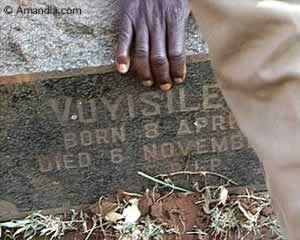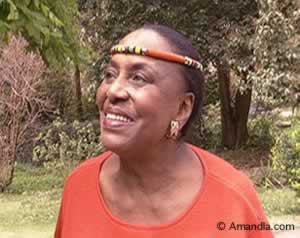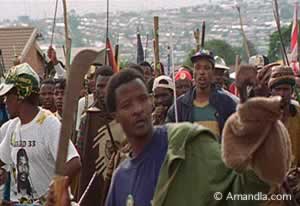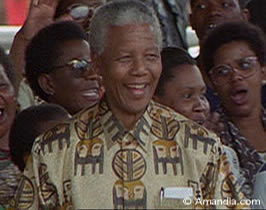“Amandla!-Awethu,” “Power to the People.” This was the rallying cry of black South Africans who resisted the apartheid regime. The cry of human voices raised in song characterized this liberation movement. As Abdullah Ibrahim aptly proclaims, “the revolution in South Africa is the only revolution anywhere in the world that was done in four-part harmony.” This statement serves as the inspiration for the title of the documentary.
There is no doubt that the music was harmonious, but this was far from a peaceful revolution. The film, directed by Lee Hirsch and produced by Sherry Simpson, features important freedom songs from the decades of apartheid rule. The material is presented in chronological order, and enhanced by rare archival footage of historic events. Throughout the film we are treated to eye-witness accounts and the personal reflections of famous South African musicians, some of whom (such as Abdullah Ibrahim, Hugh Masekela, and Miriam Makeba) were forced to live in exile from the early 1960s. They speak of their homesickness and the stark reality of being unable to return to South Africa. Dolly Rathebe sings older songs with great emotional force (e.g. “Madam Please”), while Vusi Mahlasela and Sibongile Khumalo perform their latest compositions. The voices of these and other musicians, as well as activists and freedom fighters, speak and sing of the pain, anger, and grief of apartheid.
My response to Amandla! is unavoidably located in my position as a white South African woman. Government censorship of the media ensured that many white South Africans remained in a state of partial or complete ignorance about apartheid brutalities and the terrible scenes that were flashed around the rest of the world. I grew up in a time when history textbooks began with the falsehood of the white man’s arrival to a South Africa empty of people. When censorship gradually eased in the 1990s, South Africans like me had to discover the omissions and lies in our concept of history and face the awful truths it contained. In addition to telling the story of black resistance and the importance of music in the anti-apartheid struggle, Amandla! reveals this silenced history. The use of song to tell this story is particularly important, as the intense eyes of activist Sifiso Ntuli say to us, before we even hear his words: “Song is something that we communicate to the people who otherwise would not have understood where we were coming from. You could give them a long political speech and they would still not understand, but I tell you, when you finish that song people be like I know where you guys are coming from. Death unto apartheid.” The struggle becomes the song and the song becomes the struggle.
The film is framed at the beginning and end with the 1998 exhumation of Vuyisile Mini’s remains at a pauper’s cemetery. Mini, an activist and well-known composer of freedom songs, was hanged in 1964.

His best known song, “Nantsi Indoda Emnyama” (“Here Is the Black Man”), contains a message for Dr. Hendrik Verwoerd, the father of apartheid. “Beware Verwoerd, here is the black man” is the text, the first of many catchy tunes that concealed their threatening messages through the use of cheerful melodies and vernacular languages that are mostly incomprehensible to white people.
In between, we follow apartheid history from 1948 when the Afrikaner Nationalists came into power. The 1950s encapsulated a period of optimism, despite the government’s gradual implementation of repressive apartheid policies. At this time, Sophiatown, one of the last places in South Africa where people of different races lived together, was demolished and turned into a white residential area. The efforts of young gang members (tsotsis) who wrote “we won’t move” on the walls of the houses were completely in vain—brick by brick, Sophiatown was pulled down.

The film shows us families placing their precious bundles of possessions onto government trucks and waving at the camera as they are driven away. The new abode for the black Sophiatown residents, known somewhat ironically as “Meadowlands,” is the title of a song the film features from this period, performed by the young Miriam Makeba.
When the Sharpeville shootings took place on 21 March 1960, the optimism of the 1950s turned into numb fear. Police opened fire at a peaceful demonstration against the hated pass laws, which required every black South African in an urban area to present the correct certification. Sixty-nine people were killed and many more were injured. In addition to this display of utter disregard for black lives, the government banned liberation organizations such as the African National Congress (ANC), and Nelson Mandela was sentenced to life imprisonment in 1964. The song that encapsulates the anguish of this period is the slow, heartrending melody of “Senzeni Na?”(“What Have We Done?”). The constantly repeating cycle of the words “What have we done? Our only sin is being black” linked thousands of people in mourning. Activist Duma Ndlovu explains the song’s expressive power: “‘Senzeni Na?’ like ‘We Shall Overcome,’ will take her rightful place in society, because at one time a mass body of people related to that song and touched each other’s hearts using that song.”
The Soweto uprising of 1976 ended all hope of obtaining liberation through passive resistance. Over 15,000 school children rioted in response to a government decree that Afrikaans (seen as the language of the oppressors) would be used as a medium of instruction in black schools. The riots spread throughout the country, and continued periods of unrest led to the declaration of several States of Emergency in the 1980s. Umkhonto We Sizwe (Spear of the Nation), the ANC military wing, gained an influx of new members as many young black South Africans left the country to join its ranks. In the film, one of these guerilla fighters, Lindiwe Zulu, tells of her training and experiences, and cannot contain her tears as she sings a poignant song of mourning for dead comrades. An important new combination of dance and song, known as the toyi-toyi, came from the interaction between these young people and Zimbabwean militants.

Candid, and rather eerily comical statements by retired riot policemen tell of their fear when facing thousands of weapon-waving, singing, and dancing black South Africans in this menacing toyi-toyi march for freedom.
By the time that Amandla! turns to the release of Mandela in February 1990, the audience shares the sense of palpable relief. Choirs sing joyful praises of Madiba (as he is affectionately known in the country) and we are treated to visuals of his famous “Madiba Jive.” The accounts of the previous decades, as well as those about chilling events in the Pretoria Central Prison by warden Johan Steinberg and political activist/novelist Jeremy Cronin, fade away in scenes of jubilance

and victory. We see Vuyisile Mini’s reburial with the respect due to a beloved and famous freedom fighter. Gone but obviously not forgotten.
Global audiences are most often exposed to South Africa and its music through the medium of film. Releases such as Cry Freedom, The Power of One, Mandela: Son of Africa,Father of a Nation,and now,Amandla! A Revolution in Four-Part Harmony shape the ideas that many people have about the country. Film directors, therefore, have a great responsibility to their audiences in presenting these finished products for public consumption. While Lee Hirsch has done a sterling job of coordinating this sensitive and perceptive account there are some instances of his control that are rather disturbing. The most visible of these is that Ibrahim’s statement (mentioned at the start of this review) which became part of the film’s title is shown only after the final credits have begun. Only the viewers who remain to see this clip discover that, in fact, it was a South African who provided the core idea of the film. Perhaps unintentional, these kinds of movies nevertheless continue a long history of appropriation of sounds and ideas of South African musicians and creative artists.
In addition, film viewers are never treated to a more subtle view of South African resistance music. We are never told of musical collaborations across racial divides, for example, Johnny Clegg and Sipho Mchunu, and how they faced persecution because white and black people were not allowed to appear together on stage. The story of the Afrikaner, Koos Kombuis, a leader of the alternative rock movement that influenced thousands of young white Afrikaans South Africans to reject the racist ideas of their elders, is also omitted. All white people are mistakenly referred to as “boers,” which is the Afrikaans word for “farmers,” and a disparaging term referring to Afrikaners. These essentialized categories of white and black ignore both the linguistic and cultural diversity within these groups and the heterogeneous nature of the entire South African population. This prevents the possibility of showing a more nuanced view of the apartheid struggle.
South Africa has moved on since the heady days of Mandela’s release. Its people now fight against poverty, crime, corruption, and AIDS. Amandla! is an excellent and necessary testament to the past and the fledgling hope for the future democracy. It frames significant moments in history, and yet, the daily struggle for survival continues, as does the slow process of reconciliation. Viewers of this documentary should keep in mind that the film is but a snapshot of a far broader and more complicated South African history, in which music played and will continue to play an essential role.
Marie Jorritsma
University of Pennsylvania
Bibliography
Davenport, T.R.H. and Christopher Saunders. South Africa: A Modern History.5th ed. Hampshire, England: Macmillan; New York: St. Martins, 2000.
Reader’s Digest Association. Illustrated History of South Africa: The Real Story. Revised 3rd ed. New York and Cape Town: Reader’s Digest Association, 1994.
Discography
Hirsch, Lee, Chris Tetzeli, and Sherry Simpson. Amandla! A Revolution in Four-Part Harmony: The Soundtrack. ATO Records 2003.
